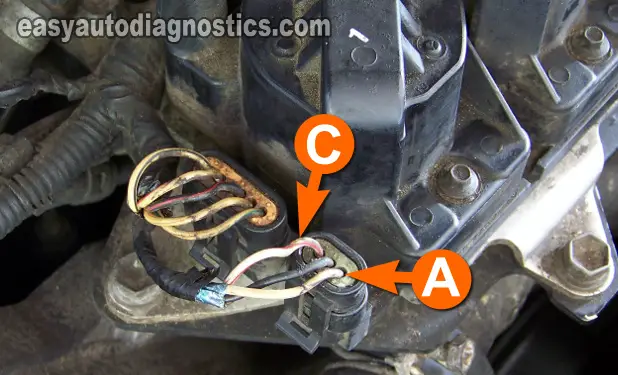TEST 2: Making Sure The Ignition Module Is Getting Ground

So far, you have confirmed that the ignition control module (on your 3.2L Isuzu Rodeo or Trooper) does have power (12 Volts). The next step is the make sure that it also has a good path to Ground.
You can use a 12 Volt test light for this test step, or a multimeter (I leave this up to you).
The following test steps assume you're using a multimeter, this is what you'll do:
- 1
Set your multimeter's dial to Volts DC.
- 2
With the black multimeter test lead, probe the wire labeled with the letter B, in the photo above.
- 3
Connect the red multimeter test lead directly on the battery positive (+) terminal.
- 4
Your multimeter should register 10 to 12 Volts DC (without having to turn the key On).
Let's take a look at what your test results mean:
CASE 1: Your multimeter registered 10 to 12 Volts. This is the correct test result.
So far so good, let's jump to the next test (which is checking that the ICM is getting a crankshaft position sensor signal): TEST 3: Testing The Crank Sensor's Signal.
CASE 2: Your multimeter DID NOT register 10 to 12 Volts. Recheck your multimeter connections and retest.
If the multimeter still doesn't display the 12 Volts, then this result eliminates the ignition control module (ICM) and crankshaft position sensor as the cause of the no-start no-spark condition on your 3.2L Isuzu Rodeo or Trooper.
Here's why: Without a good path to Ground, the ignition module won't function and this will keep the ignition system from creating and delivering spark to the engine cylinders.
TEST 3: Testing The Crank Sensor's Signal

So far, you have confirmed that the ignition control module (on your 3.2L Isuzu Rodeo or Trooper) is getting juice and has a good path to Ground. The next step is the verify that the crankshaft position (CKP) sensor is creating and providing the ICM with a CKP signal.
The crankshaft position sensor signal is critical for the ignition module since without it, the ICM will not create spark.
To successfully accomplish this test, the battery in your 3.2L Isuzu Rodeo or Trooper must be fully charged. The faster the engine turns, as you crank it, the better you'll be able to read the crankshaft position sensor's result on your multimeter.
This is what you'll do:
- 1
Set your multimeter's dial to Volts AC (Alternating Current).
- 2
With one of the two multimeter leads (it doesn't matter which one), probe the wire labeled with the letter A, in the photo above.
- 3
With the other multimeter lead, probe the wire labeled with the letter C.
- 4
Have your helper crank the engine while you eye-ball the multimeter's display.
- 5
You should see a Volts AC reading fluctuating from 0.3 Volts AC to 1.0 Volt AC.
I want to emphasize fluctuating, since you're not going to see a steady/stable Volts AC reading.
Let's take a look at what your test results mean:
CASE 1: Your multimeter registered the indicated Volts AC. This is the correct test result and it means that the crankshaft position sensor is working and providing a crankshaft position sensor signal to the ignition control module.
This result also condemns the ignition module as bad if you have:
- Confirmed that the ignition coils are not sparking.
- Confirmed that the ignition module is getting 10 to 12 Volts.
- Confirmed that the ignition module is getting Ground.
- Confirmed that the ignition module is receiving a crankshaft position sensor signal.
CASE 2: Your multimeter DID NOT register indicated Volts AC. Recheck your multimeter connections and retest.
If the multimeter still doesn't display the AC voltage, then this result tells you that the crankshaft position sensor is bad and that it is the cause of your 3.2L Isuzu Rodeo or Trooper's no-start no-spark condition. Replace the crankshaft position sensor.
Here's why: Without a crankshaft position sensor signal, the ignition control module won't function and this will keep the ignition system from creating and delivering spark to the engine cylinders.

If this info saved the day, buy me a beer!

